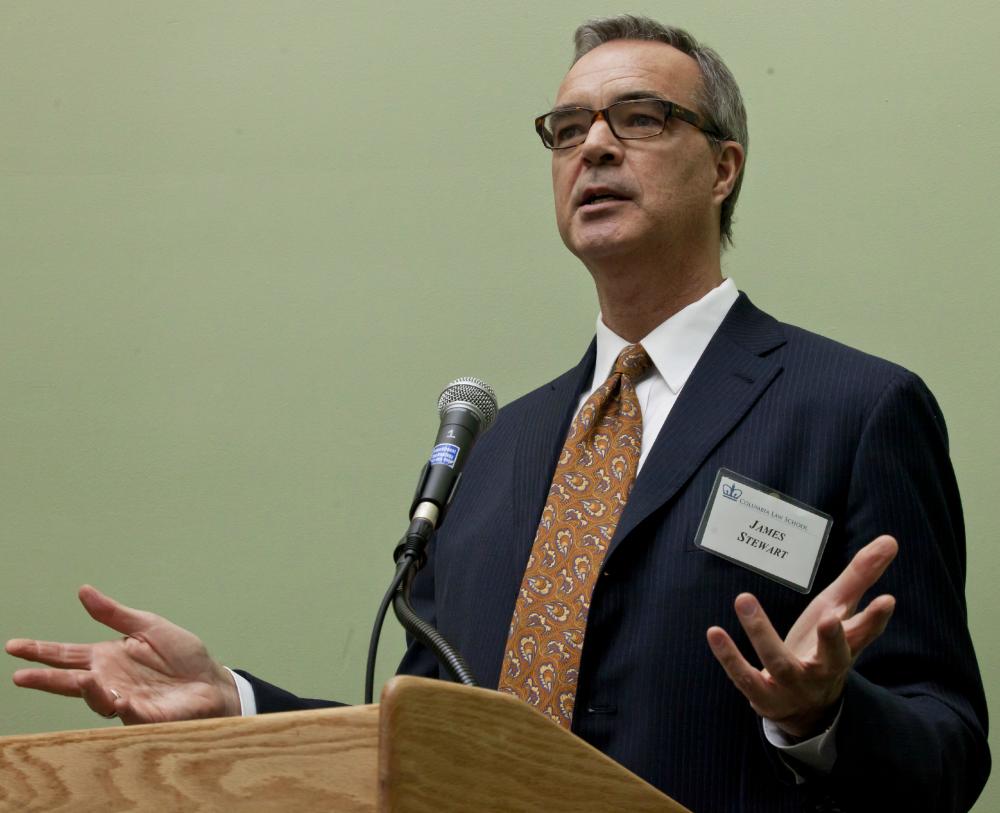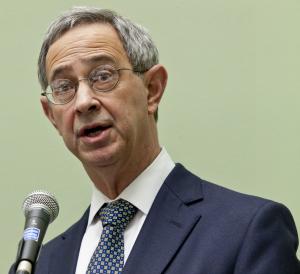Securities Law Authority, Journalist Keynote Insider Trading Conference
University of Rochester President Joel Seligman and New York Times columnist James Stewart speak about evolution of insider trading enforcement
New York, November 28, 2012—The law surrounding insider trading may be complicated, but the underlying crime is simple, according to Pulitzer Prize-winning journalist James B. Stewart, who gave a keynote address November 16 as part of a daylong conference on insider trading law and enforcement at Columbia Law School.
| James Stewart of The New York Times |
“What people respond to are powerful incentives,” said Stewart, a columnist for The New York Times and the author of Den of Thieves. “And right now the financial incentives have never been greater.”
Stewart shared the podium with University of Rochester President Joel Seligman, author of Securities Regulation, a leading treatise in the field, during a lunchtime address.
The men spoke about the history of insider trading enforcement, starting with a 1961 decision by then-Securities and Exchange Commission Chairman William Cary, a longtime Law School professor. Cary’s decision in the 1961 Cady, Roberts & Co. case spelled out for the first time the “disclose or abstain rule,” which requires an individual with non-public information about a company either to disclose it prior to selling or buying stock in that company or to abstain from such transactions.
Seligman and Stewart made their remarks after a brief introduction by Dean David M. Schizer, the Lucy G. Moses Professor of Law and the Harvey R. Miller Professor of Law and Economics, and John C. Coffee Jr., the Adolf A. Berle Professor of Law and director of the Center on Corporate Governance who chaired the conference.
“Many of you here are Columbia veterans, so you know how large business law looms at the Law School,” Schizer said. “It is such an honor to be on a faculty that [Bill Cary] was once on.”
Schizer thanked Coffee and the conference co-sponsors, including the Securities Law Section of the Federal Bar Association, The Stephen Friedman Fund in Business Law, and the F.F. Randolph, Jr. Speakers Fund.
In his remarks, Seligman said he had been personally influenced by Cary, whom he interviewed early in his career as part of a research project.
|
|
| University of Rochester President Joel Seligman |
“He looked me in the eye, and he spoke about his love of academia,” Seligman remembered. “Of all the words of encouragement to continue an academic career, none meant as much to me as Bill’s.”
When Cary joined the SEC in 1961, he inherited an organization that “seemed almost a spent force, a toothless tiger,” Seligman said. “Against this backdrop, what Cary did accomplish is remarkable.”
Seligman explained that Cary came into the SEC with one priority: to reverse state insider trading laws and decisions that had held such trading permissible under certain circumstances, which he did in one fell swoop with the Cady, Roberts decision within months of taking office.
“Five decades after the publication of Cady, Roberts, the decision endures as among the most fundamental in securities fraud enforcement,” Seligman said.
After Seligman explained some of the history behind insider trading enforcement, Stewart described some of how that enforcement played out by talking about his career as a journalist covering insider trading cases, including one in the 1980s against R. Foster Winans, a reporter colleague at The Wall Street Journal.
Stewart said the Winans case was “pennies by the standards of what was to come.” Today, because of the rise of hedge funds and the vast amount of trades that occur, much more money is at stake.
Although the original assignment to cover insider trading was not his choice, Seligman said he grew to be fascinated by the topic.
“The average American looks to insider trading cases as a proxy for whether the markets are fair,” he said, making the cases important for the integrity of the financial system.
But, beyond that, he explained, the people at the heart of insider trading cases intrigue him.
“At the individual level, why do people do this?” he asked.
Through the years, the answer seems to be money, he said. “Enormous rewards motivate this behavior, either real or implied.”

